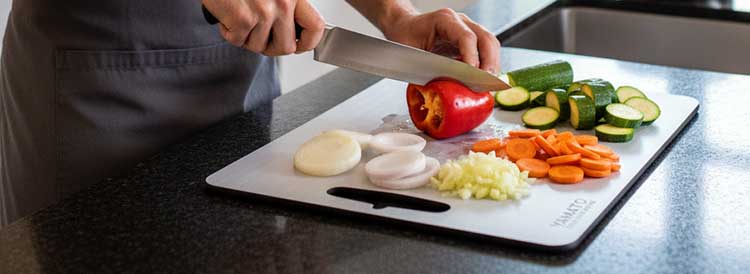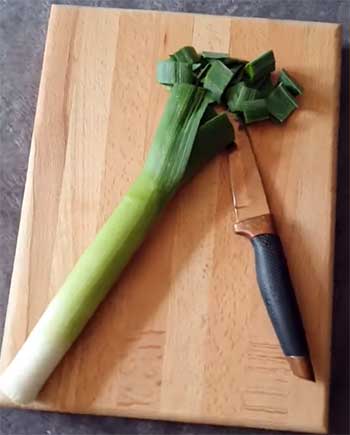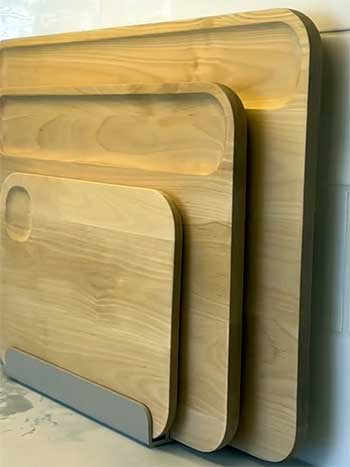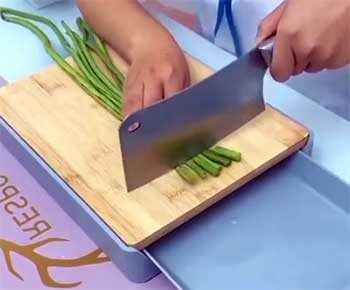Listen, if you’re tired of chopping on flimsy plastic that shreds into your meals or wood that warps after a few rainy days, grab a Yamato Cutting Board today. This titanium wonder keeps your knives sharp, your counters clean, and your sanity intact—it’s the upgrade your kitchen’s begging for.
Trust me, once you feel that smooth glide under your blade, you’ll wonder how you ever cooked without it. Go snag one; your next stir-fry will thank you.
My Hands-On Time With The Yamato Cutting Board

You know that moment when you unbox something new and it just feels right? That’s exactly what hit me the second I pulled the Yamato Cutting Board from its packaging.
I’d been juggling a mismatched set of boards—one scarred plastic number for veggies, a bamboo slab for meat that always smelled faintly of last week’s garlic, and a teak one that I’d oiled religiously but still cracked under pressure.
I cook almost every night, whipping up everything from quick weeknight tacos to elaborate Sunday roasts for friends, so my old setup was starting to feel like a chore. When I spotted the Yamato online, touted as this Japanese-engineered titanium beast, I thought, why not?
At around 12 by 8 inches, it’s compact enough for my tiny apartment counter but sturdy without being a backbreaker.
First chop: carrots for a stir-fry. I grabbed my favorite chef’s knife, a carbon steel beauty that’s picky about surfaces, and sliced down. No resistance, no drag—just a whisper of metal on metal that let the blade sing through.
The board didn’t budge thanks to those subtle rubberized grips on the bottom; I’ve had too many close calls with slippery ones sliding into the sink mid-dice. I flipped it over for the proteins—no cross-contamination worries since both sides are identical and non-porous.
Slicing chicken breasts? Effortless. The surface stayed cool, even after I absentmindedly set a hot pan on it while grabbing spices. No scorch marks, no warping.
Over the next couple of weeks, I put it through the wringer. Breakfast smoothies meant hacking frozen berries; it powered through without a hitch, and cleanup was a rinse under hot water—no scrubbing needed, unlike my wood board that soaks up juices like a sponge.
One night, I prepped a full Japanese-inspired feast: thin-sliced beef for sukiyaki, julienned veggies, and even some delicate fish fillets. The Yamato handled the precision cuts like a pro, keeping my knife’s edge honest.
I noticed something else too—my blades felt crisper afterward, not that dull tug you get from harder surfaces. And odors? Zero. That onion funk that lingers on plastic for days? Gone. I even used it as a serving tray for charcuterie; the sleek titanium finish looks sharp enough for guests, elevating my casual spreads.
But let’s be real—it’s not all perfection in the trial run. The first time I loaded it with a heavy roast, the slight flex under weight made me pause; it’s lightweight, which is great for flipping but less reassuring for massive tasks.
Still, for everyday use, it’s a game-changer. After a month, it’s my go-to, tucked neatly in a drawer when not in action. If you’re like me, someone who values efficiency without sacrificing style, this board slots right into your routine.
It makes prep feel less like work and more like the fun part of cooking—the part where you create, not just survive.
What I Love Most: The Pros of The Yamato Cutting Board

- Unmatched Durability That Holds Up to Real Life You grab this board expecting it to buckle under daily abuse, but nope—it laughs in the face of it. Crafted from what feels like pure titanium (and claims to be), it shrugs off scratches better than any plastic I’ve owned. I’ve hacked through butternut squash and pounded chicken cutlets without a single groove forming. Unlike wood that splinters or bamboo that chips, this thing stays flat and flawless. You can tell it’s built for the long haul; after weeks of me treating it like my personal battlefield, it looks brand new. If you’re rough on tools like I am—dropping it once (oops) and it bounced without a dent—you’ll appreciate how it just endures.
- Hygiene on Autopilot, No Extra Effort Here’s where it wins big for busy folks like us: the non-porous surface means bacteria have nowhere to hide. I used to stress about raw chicken juices seeping into wood pores, but with the Yamato, a quick wipe and it’s pristine. No lingering smells from fish or garlic—I’ve prepped sushi-grade tuna and followed it with citrus slices, and zero crossover. It’s like having a self-sanitizing station in your kitchen. For parents or anyone health-conscious, this cuts down on worry; you know every chop is safer without bleach sprays or endless soaks.
- Knife Whisperer: Keeps Your Edges Alive Longer Oh man, if you invest in quality knives, you’ll hug this board. The titanium is softer than steel blades, so it gives just enough without biting back. My knives glide like they’re on butter, staying razor-sharp far longer than on plastic, which shreds and dulls them fast. I’ve gone two weeks without honing, and they’re still slicing tomatoes paper-thin. It’s that subtle feedback under your hand—precise, controlled—that makes chopping meditative instead of frustrating. You feel like a pro every time.
- Lightweight Yet Sturdy, Easy to Maneuver At under two pounds, it’s a dream to shift around your counter. No more wrestling a hefty block that takes up half your space. The grips lock it down firm, so you chop one-handed if needed, grabbing herbs without pausing. I love how it doubles as a charcuterie base or hot-pan rest—versatile without bulk. For small kitchens like mine, it’s a space-saver that punches above its weight.
- Sleek Looks That Impress Without Trying Let’s talk aesthetics: this board isn’t just functional; it’s a countertop stunner. The matte titanium finish has this modern vibe that jazzes up my otherwise meh setup. Guests notice it during dinner parties, and it sparks chats about gear. You don’t have to hide it away—leave it out, and it elevates the whole vibe.
The Flip Side: Cons of The Yamato Cutting Board
- Price Tag That Stings at First Glance You look at the cost—often north of $50—and think, is this worth it over a $10 plastic? Fair question. It’s pricier upfront, especially if you’re budget-shopping. But when you factor in no replacements every six months, it evens out. Still, if cash is tight, that initial hit might pause you.
- Heavier Than It Looks for Big Jobs Wait, I said lightweight earlier, but here’s the catch: for massive meal preps, like quartering a whole chicken or big roasts, it feels a tad flexy. Not unstable, but not the rock-solid heft of thick wood. If you’re a caterer-level chopper, you might crave more mass.
- Heat Tolerance Has Limits It handles hot pans okay, but super-high temps—like direct from a screaming wok—can warm the surface uncomfortably. No melting, but you notice it. Fine for most home use, but test your setup.
- Slippery When Wet (Sometimes) The grips are great dry, but if water pools, it can skate a bit. Not a dealbreaker—dry it quick—but annoying mid-wash.
- Not Ideal for Super-Delicate Tasks For paper-thin herb slices, the firmness might feel less forgiving than soft end-grain. It works, but wood wins there.
Maintenance Tips For Your Yamato Cutting Board
- Daily Cleaning: Keep It Simple and Swift

You don’t want your post-dinner routine dragging on, right?
For everyday use, hit the Yamato with warm water and a drop of mild dish soap right after chopping.
I grab a soft sponge—no abrasives, since that titanium finish is smooth but scratches show if you’re rough.
Scrub in circles to lift any residue; it’ll rinse clean in seconds because nothing sticks.
Pat dry with a towel or let it air-dry upright—propping it against your backsplash works wonders to avoid water spots. Do this consistently, and you’ll never deal with buildup.
I’ve skipped it once or twice after lazy nights, and sure enough, faint stains appear, but a soak fixes it fast.
- Deep Cleaning: When It Needs a Spa Day
Every couple of weeks, or after heavy meat prep, give it a deeper refresh. Soak in hot, soapy water for 10 minutes, then gently scrub with a non-scratch pad. For stubborn bits—like berry juice—white vinegar diluted 1:1 with water does the trick without harsh chemicals.
Avoid bleach; it can etch the surface over time. Rinse thoroughly, dry completely, and you’re golden. Dishwasher-safe? Technically yes, but I skip it—top rack on gentle keeps the shine, but hand-washing preserves that factory-fresh feel longer.
You owe it to yourself to make this effortless; it’s why I love this board.
- Storage Secrets: Tuck It Away Smart
Space is premium in most kitchens, so store smart. I stand mine on edge in a cabinet slot—prevents warping (though titanium laughs at that) and lets air circulate. If stacking, layer with a cloth to avoid scratches. Keep it away from direct sun; UV can fade the finish subtly.
For travel, like picnics, wrap in a towel—it fits in bags easy. Proper storage means it’s always ready, no fumbling.
- Avoiding Wear: Pro Moves for Longevity
Want it lasting years? Use proper technique: rock your knife instead of hacking straight down to minimize marks. Rotate sides weekly to even wear. If you spot micro-scratches, a soft cloth with baking soda paste buffs them out gently.
No oiling needed—unlike wood, it doesn’t dry out. Heat it gradually if resting hot items; sudden blasts can stress the metal. These habits keep it performing like day one.
Comparing The Yamato To Other Cutting Board Favorites
- Yamato Vs. Beech: The Everyday Workhorse

You spot those affordable beech boards at kitchen stores—light-colored, smooth grain, and budget-friendly at around $20 for a decent size.
Beech feels solid under your hand, with a tight grain that resists deep knife marks better than softer pines, and it’s gentle enough on blades for daily veggie chops.
I used a beech one for months; it handled onions and herbs without much scarring, and the natural wood vibe warms up your counter.
Oil it occasionally, and it stays hydrated, avoiding cracks in dry winters.
But stack it next to the Yamato, and the differences pop. Beech absorbs juices—beet stains linger pink no matter how you scrub, and garlic odors sneak in after a while. Yamato’s titanium shrugs off colors and smells entirely; a quick rinse, and it’s like new.
Weight-wise, beech has that satisfying heft for stability, but it warps if you forget to dry it properly—I’ve seen edges curl after sink soaks. Yamato stays flat forever, no humidity drama. Knife care? Beech is kind, but not as forgiving as Yamato’s engineered softness; my edges stayed crisper longer on titanium.
For the price, beech wins entry-level appeal, yet Yamato’s zero-maintenance hygiene makes it the smarter long-term play if you cook often.
- Yamato Vs. Caraway: The Stylish Nonstick Contender

Caraway boards come in those trendy pastel hues, ceramic-coated composites that promise nonstick ease and dishwasher safety.
They’re thin, lightweight, and stack neatly—perfect for small spaces.
The surface repels water like magic; juices bead up, and cleanup feels effortless.
I tested one for a week of meal preps; it sliced through tomatoes without sticking, and the colors matched my pots for that Instagram look.
Compare directly to Yamato, though, and Caraway’s coating shows limits.
After repeated knife action, micro-scratches appear, dulling the shine and potentially trapping bits over time. Yamato’s pure titanium resists scratches way better—no coating to wear off.
Heat tolerance?
Caraway warns against hot pans; it can chip the finish. Yamato takes brief hot rests without flinching. On knives, Caraway’s harder ceramic bites edges faster—I noticed more frequent sharpening. Yamato glides gentler, preserving sharpness.
Caraway costs similar mid-range, but its style-over-substance vibe fades; Yamato’s sleek metal endures quietly, winning on pure performance for serious cooks who value longevity over aesthetics.
- Yamato Vs. Acacia: The Exotic Wood Charmer

Acacia boards bring that rich, swirling grain—dark streaks against golden hues that make your kitchen feel upscale.
They’re end-grain often, super knife-friendly with self-healing fibers that close up after cuts.
Pound chicken or chop nuts; the board bounces back. Mine was a gift, thick and heavy, great for big roasts where stability matters.
The natural oils in acacia fight bacteria decently, and it develops a patina that tells your cooking story.
Yet, face Yamato head-on, and acacia demands care. Monthly mineral oil rubs to prevent drying—skip it, and cracks form, especially in air-conditioned rooms. Yamato needs nothing, ever. Stains?
Turmeric turns acacia yellow permanently; Yamato wipes clean. Weight is acacia’s double-edged sword—steady but a pain to move or store.
Yamato’s feather-light for quick grabs. Odors linger in wood pores despite washes; titanium stays neutral. Knife mercy is close—both excel—but acacia dulls slightly faster from density variations. Priced higher than basic woods, acacia tempts with beauty, but Yamato’s effortless sanitation and portability seal the deal for practical daily use without the upkeep ritual.
Also Read: Comparison of Beech And Acacia Cutting Boards.
Frequently Asked Questions (FAQ)
From what I’ve seen in kitchens and studies, wooden boards top the list for health—hardwoods like maple have natural antimicrobial properties that trap and kill bacteria better than plastic, which sheds microplastics into food over time. Avoid glass or hard synthetics; they harbor nothing but dull your knives. Titanium like Yamato ranks high too—non-porous, no leaching, pure hygiene without the wood’s upkeep.
Not really—it’s designed softer than most blade steels, so your edges stay sharper longer than on plastic or glass. I’ve tested it; after a month of daily chops, my knives needed less touch-up than before. Some harder metals do, but Yamato balances durability without the bite.
Gordon’s all about those thick John Boos maple blocks—end-grain for knife mercy and stability. He raves about their heft in his MasterClass, using them for everything from filleting fish to smashing burgers. Solid choice for pros, though it demands oiling.
The branding screams Japanese engineering, with titanium sourced and crafted to those precision standards. It’s marketed as pure Japan-made, focusing on quality like traditional bladesmiths—though some supply chains mix it up, the core design holds that heritage.
Wrapping It Up: Make the Switch To Yamato Today
There you have it—my no-holds-barred take on the Yamato Cutting Board after months of real-kitchen battles. It transforms prep from hassle to joy, blending toughness with ease in a way few tools do. If you’re ready to ditch the old frustrations and step up your game, this is your move.
Your knives, your meals, and your peace of mind will soar. Head out and get one; that first perfect slice awaits.
